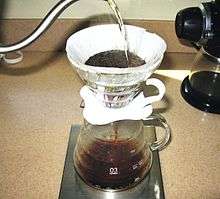Percolation

In physics, chemistry and materials science, percolation (from Latin percōlāre, "to filter" or "trickle through") refers to the movement and filtering of fluids through porous materials.
Background
During the last decades, percolation theory, the mathematical study of percolation, has brought new understanding and techniques to a broad range of topics in physics, materials science, complex networks, epidemiology, and other fields. For example, in geology, percolation refers to filtration of water through soil and permeable rocks. The water flows to recharge the groundwater in the water table and aquifers. In places where infiltration basins or septic drain fields are planned to dispose of substantial amounts of water, a percolation test is needed beforehand to determine whether the intended structure is likely to succeed or fail.
Percolation typically exhibits universality. Statistical physics concepts such as scaling theory, renormalization, phase transition, critical phenomena and fractals are used to characterize percolation properties. Combinatorics is commonly employed to study percolation thresholds.
Due to the complexity involved in obtaining exact results from analytical models of percolation, computer simulations are typically used. The current fastest algorithm for percolation was published in 2000 by Mark Newman and Robert Ziff.[1]
Examples
- Coffee percolation, where the solvent is water, the permeable substance is the coffee grounds, and the soluble constituents are the chemical compounds that give coffee its color, taste, and aroma.
- Movement of weathered material down on a slope under the earth's surface.
- Cracking of trees with the presence of two conditions, sunlight and under the influence of pressure.
- Robustness of networks to random and targeted attacks.
- Transport in porous media.
- Epidemic spreading.[2][3]
- Surface roughening.
- Dental percolation, increase rate of decay under crowns because of a conducive environment for strep mutants and lactobacillus
- Potential sites for septic systems are tested by the "perk test". Example/theory: A hole (usually 6–10 inches in diameter) is dug in the ground surface (usually 12–24" deep). Water is filled in to the hole, and the time is measured for a drop of one inch in the water surface. If the water surface quickly drops, as usually seen in poorly-graded sands, then it is a potentially good place for a septic "leach field". If the hydraulic conductivity of the site is low (usually in clayey and loamy soils), then the site is undesirable.
See also
- Branched polymer
- Conductance
- Critical exponents
- Fragmentation
- Gelation
- Groundwater recharge
- Immunization
- Network theory
- Percolation critical exponents
- Percolation theory
- Percolation threshold
- Polymerization
- Self-organization
- Self-organized criticality
- Septic tank
- Supercooled water
- Water pipe percolator
References
- ↑ Newman, Mark; Ziff, Robert (2000). "Efficient Monte Carlo Algorithm and High-Precision Results for Percolation". Physical Review Letters. 85 (19): 4104–4107. arXiv:cond-mat/0005264. Bibcode:2000PhRvL..85.4104N. CiteSeerX 10.1.1.310.4632. doi:10.1103/PhysRevLett.85.4104. PMID 11056635.
- ↑ Parshani, Roni; Carmi, Shai; Havlin, Shlomo (2587). "Epidemic Threshold for the Susceptible-Infectious-Susceptible Model on Random Networks". Physical Review Letters. 104 (25): 258701. arXiv:0909.3811. Bibcode:2010PhRvL.104y8701P. doi:10.1103/PhysRevLett.104.258701. ISSN 0031-9007. PMID 20867419. Check date values in:
|year=(help) - ↑ Grassberger, P. "On the Critical Behavior of the General Epidemic Process and Dynamic Percolation". Mathematical Biosciences. Missing or empty
|url=(help)
Further reading
- Harry Kesten, What is percolation? Notices of the AMS, May 2006.
- Muhammad Sahimi. Applications of Percolation Theory. Taylor & Francis, 1994. ISBN 0-7484-0075-3 (cloth), ISBN 0-7484-0076-1 (paper)
- Geoffrey Grimmett. Percolation (2. ed). Springer Verlag, 1999.
- D.Stauffer and A.Aharony. Introduction to Percolation Theory
- A. Bunde, S. Havlin (Editors) Fractals and Disordered Systems, Springer, 1996
- S. Kirkpatrick Percolation and conduction Rev. Mod. Phys. 45, 574, 1973
- D. Ben-Avraham, S. Havlin Diffusion and Reactions in Fractals and Disordered Systems, Cambridge University Press, 2000
- Edouard Rodrigues, Remarkable properties of pawns on a hexboard
- R. Cohen and S. Havlin Complex Networks: Structure, Robustness and Function
- Bollobás, Béla; Riordan, Oliver (2006), Percolation, Cambridge University Press, ISBN 0521872324
- Grimmett, Geoffrey (1999), Percolation, Springer